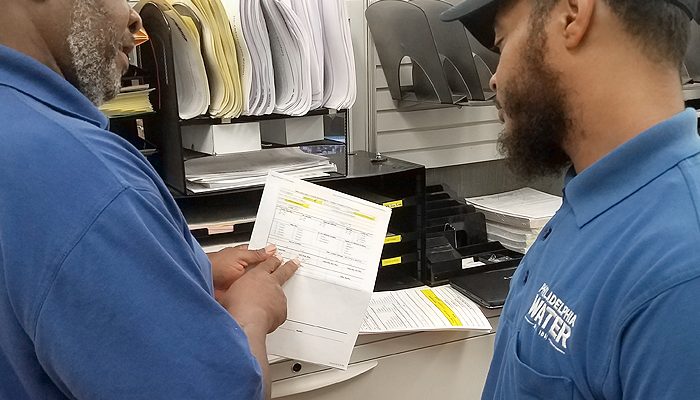Where is lead found?
Most children who have lead poisoning get it from lead paint in their home. Some homes have lead in their pipes or in their water fixtures. Lead can also be found in soil, and lead dust from construction can get into the air, or onto the clothing of people who work in construction.
Lead in and around your home
Most children who have lead poisoning get it from lead dust in homes built before 1978. When old lead paint cracks and peels, it creates lead dust. Lead dust from chipping paint can settle on the ground and other surfaces and get on children’s hands.
Lead can get into drinking water if you have a lead service line, or plumbing fixtures that have lead.
You can also be exposed to lead from soil that is contaminated by lead from exterior paint. Lead is sometimes found in the following products when they are made outside the United States:
- Pottery
- Children’s toys
- Jewelry
- Food
- Health remedies and cosmetics such as kohl, kajal, and surma
Learn more about sources of lead.
Philadelphia’s Lead and Healthy Homes Program works to ensure that Philadelphians have safe and healthy homes, free from lead and other hazards. Landlords and tenants also play an important role in ensuring that rental homes are healthy and safe.
Lead in plumbing
The Philadelphia Water Department (PWD) tests water both when it leaves our treatment plants and in homes with lead service lines to be sure that it is and remains safe to drink. Water in Philadelphia meets or exceeds the standards needed to be safe for drinking and bathing. None of the City’s water mains are made of lead.
There are two major ways lead can get into water in Philadelphia:
- When water sits in plumbing made from lead
- When pieces of lead plumbing or solder break off inside drinking water pipes
In Philadelphia, water is treated to make it safer for homes that have lead plumbing, but there is always a risk of lead getting into water when you have lead in your plumbing.
Watch a video about how lead gets into water.
Philadelphia’s water quality
The drinking water in Philadelphia meets or exceeds state and federal water quality standards. For yearly water quality data, visit the Philadelphia Water Department’s drinking water quality page.
Lead and drinking water quality
Philadelphia’s drinking water sources, the Delaware and Schuylkill Rivers, do not contain detectable levels of lead. When lead is found in drinking water, the lead is coming from home plumbing.
The PWD treats the water with an anti-corrosion treatment that helps prevent lead from leaching out of household pipes when it sits in pipes for six or more hours. This treatment prevents Philadelphia from experiencing a lead crisis similar to those seen in other American cities.
Monitoring for lead in Philadelphia’s drinking water
Philadelphia’s water supply is carefully monitored to make sure that residents are protected from lead that could be found in drinking water. The PWD is required by law to test drinking water from homes with lead service lines every three years to ensure that corrosion control treatment is working.
Since June 1991, the PWD has tested for lead levels in accordance with the federal Lead and Copper Rule.
Lead pipes in your home
It is estimated that approximately 20,000 Philadelphia homes may have a water service line (a pipe running from the water main to the home) that is made of lead. Older brass fixtures, valves, and solder (where pipes are joined) may also contain lead. Replacing an older brass faucet or valve may be a simple way to reduce lead.
As part of a new federal initiative to identify and replace lead service lines in the country, PWD created a map of all Philadelphia service lines and their material (when known). You can check the material of your service line using your address.
To find out if your water service line is made of lead, follow these steps or use the diagram (PDF):
- Find the water meter in your basement. Look at the pipe that comes through the outside wall of your home and connects to your meter.
- If the pipe is painted, use sandpaper to expose the metal. Carefully scratch the metal pipe with a key or a coin. Do not use a knife or other sharp tool. Take care not to make a hole in the pipe. If the scratch turns a shiny silver color, it could be lead or steel.
- To determine if the pipe is lead or steel, get a strong refrigerator magnet. Place the magnet on the pipe. If a magnet sticks, it is a steel pipe.
- You can also buy a lead test kit at a hardware or home improvement store. These kits are used to test what the pipe is made from—not the water inside. Look for an EPA-recognized kit.
If you don’t have a lead service line but do have lead in your water, a licensed and registered plumber can inspect your pipes and other plumbing for lead.
Living with lead pipes
If you have lead pipes, one way to keep your family safe is to flush your pipes. Anytime you have not used the water in your home for six hours or more you should flush your pipes.
To flush your pipes, turn on the cold water faucet at the sinks where you get water for drinking and cooking and let the water run for three to five minutes.
Other household water uses like washing clothes, showering, or flushing the toilet are also good ways to bring fresh water from our system into your home plumbing. Flushing your pipes removes lead that may have gotten into your water while it was sitting in the pipes.
It is also important to clean faucet aerators and screens to remove any debris from them.
Find videos and printable flushing instructions to learn more about flushing your pipes.
If pipes have been disturbed
In some situations, customers with lead pipes should do a more thorough flush of their pipes (PDF).
- After street work, such as resurfacing or heavy construction that can dislodge lead particles.
- After your lead line is replaced, which may cause lead particles to break off into plumbing.
Replace lead pipes
In Philadelphia, there are two programs to help homeowners replace lead service lines.
- The Homeowners Emergency Loan Program (HELP) is a zero-interest loan for homeowners who want to replace a water service line made of lead.
- If the City is replacing the water main on your street and your water service line is made of lead, the City will replace your water service line for free. You must give permission for the City to do this. PWD will notify residents by letter several months before work is scheduled to begin.
You may also contact any licensed plumber to give an estimate for replacing lead service lines and other sources of lead in plumbing.
Finding and replacing lead plumbing can be expensive, but removing lead permanently is the safest option.
Lead in soil
Lead can get into soil from flaking paint on the outside of houses, from leaded gasoline from cars, and from old industrial operations. Lead in soil can be tracked into homes on shoes, clothing, and tools.
If you decide to get your soil tested for lead, be sure to use a reputable testing laboratory.
The results will have a number in parts per million (ppm).
| Lead level (parts per million) | Level of lead contamination |
|---|---|
| Less than 150 | None to very low. Most soil has low levels of lead in it (10—50 ppm). |
| From 150 to 400 | Low. Precautions like washing hands and planting gardens far from streets and old buildings should be enough. |
| From 400 to 1,000 | Medium. Treatment is required for play areas used by children under six years old. Take additional precautions before gardening. |
| Greater than 1,000 | High. Do not garden in this soil and do not allow children to come into contact with it. |
To avoid getting exposed to lead from soil you can:
- Keep soil covered using concrete, grass (where it grows well), or landscape fabric plus mulch (where grass does not grow well).
- Put your garden or children’s play area as far away as possible from busy streets or highways and older buildings, and away from where storm gutters empty next to your house.
- Wipe your feet on heavy duty door mats inside and outside. Leave your shoes at the door.
- Wash your child’s hands after they play outside.
If you want to grow food in your backyard, you can:
- Use raised planting beds.
- Cover the garden area with landscape fabric and then with fresh soil and compost.
- Be sure to wash and peel fruits and vegetables that you grow.
Lead from construction
Construction and demolition projects around your home may create lead dust. You can help to reduce your risk of exposure.
- Keep windows closed during peak work times.
- Regularly wet-mop floors and wet-wipe window sills.
- Avoid tracking soil into your house. Put doormats outside and inside all entryways. Remove your shoes before coming inside.
- Regularly wash your children’s hands and toys.
If you are renovating your home:
The EPA has established rules for anyone who performs renovation in a house, apartment, school or facility built before 1978. Contractors or workers renovating these buildings must be trained and certified in EPA Renovation, Repair, and Painting (RRP). Information about EPA-approved training providers and certified renovators is available at EPA’s Renovation, Repair, and Painting Program website.
You can find out more about lead and construction from the Occupational Health and Safety Administration.
Rules for construction and demolition projects
In 2016, the City of Philadelphia’s Air Pollution Control Board created requirements designed to limit the public’s exposure to dust. Property owners and operators of construction or demolition projects must:
- Notify people who live near pending construction or demolition projects at least 10 days before starting work.
- Use basic dust control techniques to reduce and limit the creation of lead dust.
Find out more about lead poisoning


